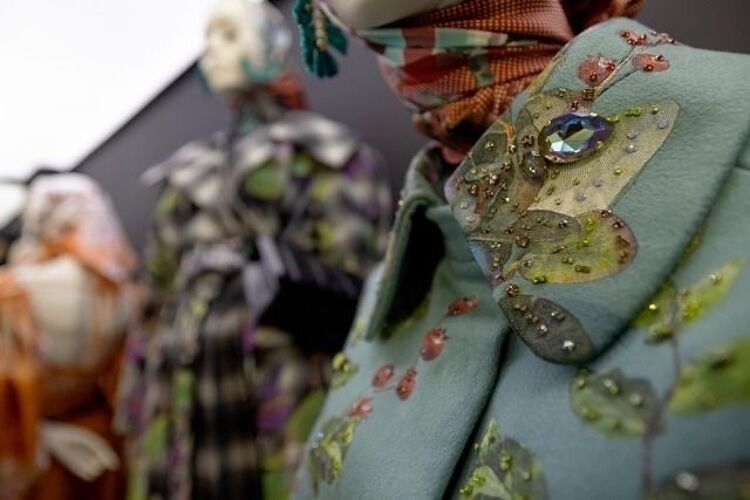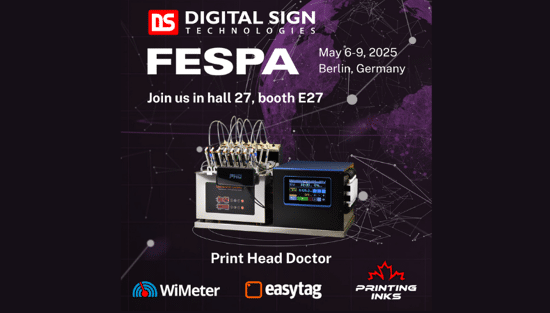Innovations Driving the Growth of Digital Textile Printing

Debbie McKeegan discusses how the digital textile printing market is being driven by market trends, technical innovation and new production solutions. During 2023, one of the biggest trends is how the industry is offering one-step digital textile, DTF pigment printing and the second trend is the growth in demand for DTF digital printers.
The digital textile printing market, driven by market trends, technical innovation and consequent new production solutions is growing extensively, and during the first half of 2023 two significant trends have emerged that have added a significant impetus to its progression.
In a textile printing market in which Digital Textile Printing is predicted to be worth over USD $8 billion by 2030 (Grand View Research), and where some experts believe that 25% of all printed textile production will be digital by 2040 - machinery makers, software houses and ink manufacturers have together, made 2023 a year to remember.
 Caption 3: The success of these new machines is a direct result of recent innovations providing improved handle and durability, a much faster product production rate - the film is first digitally printed, used immediately or stored prior to transfer to garment.Caption: Credit: STS / Debbie McKeegan
Caption 3: The success of these new machines is a direct result of recent innovations providing improved handle and durability, a much faster product production rate - the film is first digitally printed, used immediately or stored prior to transfer to garment.Caption: Credit: STS / Debbie McKeegan
In 2023, the most significant trend is the move to offering one-step digital textile, direct to fabric pigment printing across the marketplace, from industrial volume to SME’s of varying scales.
One-Step digital textile printing simplifies the manufacturing process and removes the requirement for additional ancillary resources: saving water, energy and time in the process. In One-Step production, the fabric doesn’t require pre or post-treatment, finished production is all taken care of and these R2R textiles are ready to dispatch.
Kornit Digital, first disrupted the direct to fabric print market with the Presto machine in 2019. Their one step digital textile, direct to fabric, pigment machine was a revolutionary concept. Since that launch, Kornit have continued development, adding a fabric softener to the NeoPigment™ Robusto ink as well as, ground breaking XDI technology which allows the production of surface effects directly onto printed fabric. The resultant fabrics are vibrant in colour, soft to the touch and, because the process uses pigment inks, available for use on the entire range of fabric compositions from Silk and Cotton to Polyester and Polyester blends.
Across the entire print machinery community, single-step has continued to evolve and 2023 has seen a colossal increase in the availability of machinery for one-step digital textile printing using pigment inks:
At Optimum Digital the Nirvana printing machine, which offers a waterless textile printing solution without the need for pre and post treatment, helps the print house contribute to the protection of rapidly decreasing clean water resources across the globe, and importantly reduces the operational costs of the printer. Optimal Digital state that: “this sustainable textile printing solution from Optimum Digital reduces the overall cost of print by 50% and energy and chemical costs by 80% in addition to conserving natural resources and preventing wastewater generation”.
At D.gen, the Artrix H8 which uses CBS (pre-treatment by print heads) Technology to ensure that the in-line fixation system helps reduce costs and increase profitability by speeding up the process. D-gen commented: “The printing process with pigment inks is direct and doesn't require coating and finishing operations, such as steaming and washing, delivering vibrant colours and perfect softness for just-in-time delivery or sewing”.
At MS Printing Solutions the new JP7 Pigment machine is offered using Digistar Pigment 4K, from JK Group, in a patent pending ink that doesn’t require pre- and post-treatment. MS commented: “The complete JP7 solution reduces the digital printing process steps by 50%, water consumption by 100%, and generally reduces energy consumption”.
At Aleph, their one-step machine the 400H prints at 150 m2/hr, to non-coated fabrics with a fully integrated in-line solution with their new highly innovative pigment inks. “A simple, waterless sustainable alternative to reactive dye printing”.
At Atexco, their X-1-Pro model uses nine printheads, 2 for pre-treatment, six for inks and 1 for post treatment, which with fixation in-line delivers a truly one step process.
 Caption: EFI Reggiani’s ecoTERRA digital textile printer, offers an all-in-one solution for water-based pigment printing that requires no ancillary equipment for pre- and post-treatment. Credit: EFI Reggiani / Debbie McKeegan
Caption: EFI Reggiani’s ecoTERRA digital textile printer, offers an all-in-one solution for water-based pigment printing that requires no ancillary equipment for pre- and post-treatment. Credit: EFI Reggiani / Debbie McKeegan
EFI Reggiani’s ecoTERRA digital textile printer, offers an all-in-one solution for water-based pigment printing that requires no ancillary equipment for pre- and post-treatment. According to the company, the newest lineup “significantly reduces water, energy, and chemicals consumption in the overall process”—resulting in a sustainable, direct-to-fabric printing solution.
Beyond these offerings, there were another five or six ranging from Epson’s ML 13000 concept machine to the Kyocera FOREARTH, all of which offer a one-step digital pigment printing process. As 2023 progresses, machinery buyers and potential manufacturers have an increased range of One-Step machinery and inks to choose from, with sales reflecting the interest that has been shown.
The second significant movement in the market is the growth of demand for Direct to Film (DTF) Digital Printers.
DTF technology has been in the background for a number of years, and was previously adopted by smaller scale, SME’s, craft printers and independents. The machinery on offer was small scale desk-top type devices.
However, DTF has become more prominent during the course of the last year, with the availability of higher volume production DTF technologies which have opened up the market - with particular emphasis on sportswear, customised workwear and personalised garments. The success of these new machines is a direct result of recent innovations providing a much faster product production rate - the film is first digitally printed, used immediately or stored prior to transfer to garments. DTF offers the printer a variable production process, reportedly cheaper than DTG with added ease of use. It demonstrates once again the market shift to one-step, inline print solutions:
Hanrun Paper now offer their EVO A-600 DTF printer with high automation capabilities, and the SEN A-331 DTF printer with integrated printing, shaking and drying. Hanrun highlighted “the perfect colour reproduction, fine and smooth lines, and soft and flexible printing texture of DTF printing and the DTF hot stamping effect, which adds boldness and sparkle to garment designs with DTF gold foil printing” when using their technology.
Adelco's DTF printer is a four-headed DTF printer, with an automatic re-circulation powder and dryer system. Adelco say that “the brand-new DTF printer is the fastest and highest-spec digital, direct-to-film printer in the market. Delivering high-definition prints in various fabrics with its incorporated eco-friendly water-based pigment ink. Supplemented with an in-line drying and cooler system”.
 Caption: One-Step digital textile printing simplifies the manufacturing process and removes the requirement for additional ancillary resources: saving water, energy and time in the process. Credit: Kornit Digital / Debbie McKeegan
Caption: One-Step digital textile printing simplifies the manufacturing process and removes the requirement for additional ancillary resources: saving water, energy and time in the process. Credit: Kornit Digital / Debbie McKeegan
The TxF150-75 is Mimaki’s first DTF (Direct-to-Film) printer was launched earlier this year. Packed with Mimaki technology to overcome the common ink ejection and ink sedimentation issues of current DTF printers in the market. “Using genuine Mimaki heat transfer pigment ink, which has acquired ECO PASSPORT certification, it assures skin friendly printing at the highest image quality. This unique combination ensures a highly reliable and stable DTF print workflow, and is combined with Mimaki’s guaranteed ongoing service and after purchase support”.
Epson’s hybrid SureColor F2270 for both direct-to-garment (DTG) and direct-to-film (DTF) printing has also just arrived onto the marketplace. The hybrid SureColor F2270 DTG printer incorporates DTF printing capabilities and goes beyond traditional garment printing and transfer to a wider variety of materials, including uniquely shaped items.
From STS Inks comes the STS XPJ 1682D 64” DTF Printer from Japan which has a staggered dual-head design that provides ultra-fast print speeds. STS commented: “It produces smooth gradations while delivering high-quality printing even with reduced resolution. The XPJ-1682D features automatic bi-directional alignments, a user-friendly touch panel, added LED lighting, and an upgraded media feed flange that allows operators to easily and quickly load media and exchange multiple rolls. The XPJ-1682D is paired with STS’s DTF ink, which offers users excellent colour gamut and outstanding durability”.
The march of DTF has the potential to disrupt the DTG market. In further developments for DTF there has also been significant progress in DTF ink developments:
Dupont, for example, now offer the Artistri® P1600 direct-to-film (DTF) pigment inks which they say “are ideal for DTF printers looking for a professionally printed product with consistent, vibrant colors on a variety of fabrics. The Artistri® P1600 DTF ink set allows for profiling with reduced ink volume delivering both efficiency and productivity as equipment runs cleaner for longer”.
And InkTec say that “their (DTF) printing ink, offered in a range of colours including CMYK, plus white, gives a superior printing quality and vivid colour performance, even when used with delicate graphics. Compatible with printers with the Epson i3200 print head. It has an excellent adhesion and transfer rate, offers a superior soap and water resistance and maintains consistent printing quality under high speeds with lower production costs”.
As can be seen from the array of new developments above, the growth of One-Step Digital Pigment printers and the advance of DTF digital printing have provided two vibrant avenues for growth for the Digital Textile Community.
Both of these trends show that the Digital Print Industry is not simply treading water, but examining every technological horizon to both disrupt and continue to create new applications, generating new markets and infinite commercial opportunities.
Topics
Interested in joining our community?
Enquire today about joining your local FESPA Association or FESPA Direct
Recent news

FESPA 2025 Feature Programme confirmed: both new and returning
FESPA Global Print Expo 2025 is set to introduce its newest editions to its feature programme, SmartHub and the ESE Pavilion, as well as welcome the return of existing features: the 2025 FESPA Awards; the high-adrenaline World Wrap Masters competition; and the Club FESPA Lounge.
.png?width=550)
My Personalisation Experience
Richard Askam, a pioneer in Personalisation, transitioned from the drinks industry to creating iconic campaigns like Coca-Cola's "Share a Coke." His speaking career, includes leading a TEDx talk, becoming an ambassador for FESPA . In the past, he has led the conference sessions for the Personalisation Experience" conference, and will return this year to speak in a panel discussion.

What Does LED Lighting Do for Your Textile Frame?
LED lighting transforms textile frames, enhancing visibility and colour vibrancy for impactful displays. At European Sign Expo 2025, EFKA will showcase innovative illuminated and non-illuminated frames, including 3D and modular designs. LED's energy efficiency and storytelling potential make them crucial for modern visual communication.
